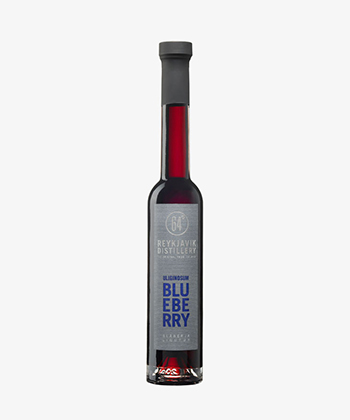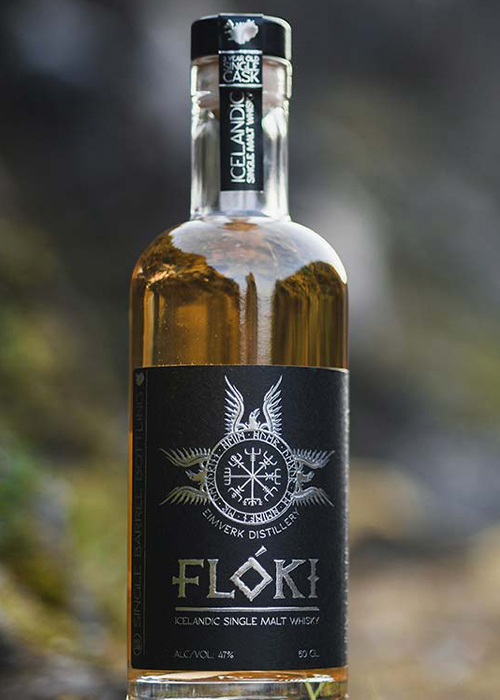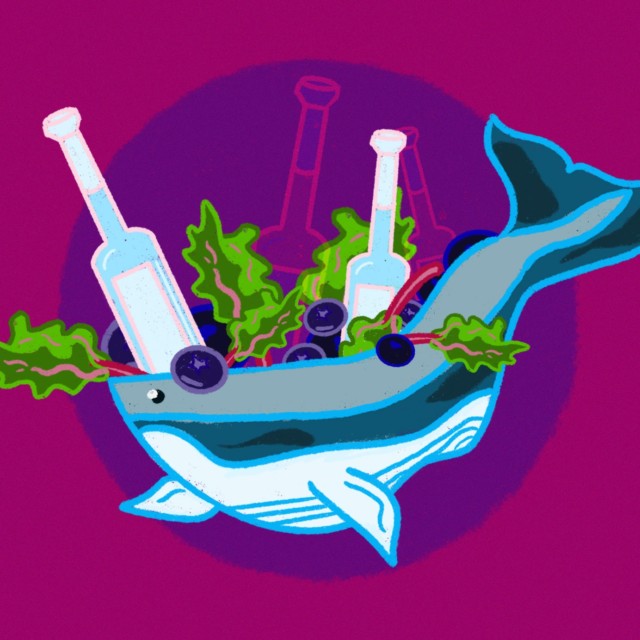There are certain big-name spirits hailing from Iceland, though the degree to which they do indeed originate in the country can be called into question. “Nobody is making neutral grain spirits in Iceland — it’s all imported,” says Halli Thorkelsson, founder of Eimverk Distillery, based a few miles outside of Reykjavik. That is to say, a large-volume vodka brand boasting an Icelandic image may go through its final stages of production in Iceland, but it doesn’t begin its journey there.
There are Icelandic distilleries producing spirits from start to finish, though. Eimverk is one of them, founded in 2010 and producing a range of products including gin, whiskey, and brennivín, Iceland’s native spirit. And 64° Reykjavik Distillery, which in 2009 became the first fully operating distillery in the country, offers botanically driven liqueurs with the requisite gin and brennivín to match as well.
These are Icelandic distilleries that share authentic flavors through local ingredients and practices; and whose whiskeys, gins, and brennivíns have deep connections to their place of origin.
Icelandic Distilleries Evocative of Their Homes
“We were inspired by the ‘New Nordic’ cuisine,” says Snorri Jónsson, founder and distiller of 64° Reykjavik Distillery. (The 64th parallel north passes through Reykjavik.) “The basic question we started with was, ‘What can we do with the fantastic berries we can find around the island?’ So, we started experimenting with the local garden, all of our wonderful berries and botanicals.”
The result is the core of 64° Reykjavik’s lineup, a trio of stunning liqueurs: wild-picked Blueberry, the brightest blueberry you’re ever likely to find bottled, with two local varieties, including Arctic bilberries; Rhubarb, a signature showcase of a hearty vegetable that loves its Icelandic environs; and Crowberry, perhaps the only 100 percent crowberry liqueur in the world. (Flavor-wise, think of it like a cross between blackberries and sour plum, with touches of vanilla and licorice.)
“The big imported brands don’t have anything to compete with this,” Jónsson says. He’s right — any of the three could be deployed in a refreshing tonic cocktail, used as a modifier in something craftier, sipped neat, or even drizzled over skyr, essentially Icelandic yogurt, for dessert.

Jónsson’s gins were the first distilled on the island, and include Einiberja, made with two types of juniper, including Icelandic juniper, as its only botanicals; and Angelica, which includes both junipers and adds a more robust botanical set including angelica, blueberries, rhubarb, and Arctic thyme.
Eimverk has started to make rye whiskey, and is experimenting with numerous other spirits, though its Flóki single malt is its centerpiece. “We are first and foremost a whiskey distillery,” Thorkelsson says. The barley is grown in Iceland, and Thorkelsson says that in comparison to commodity varieties grown in the U.K., it offers a great deal of flavor.
If you’ve heard of Flóki before, it’s probably due to the use of a rather special ingredient. “We use the good shit,” Thorkelsson says. “It’s hard to get good shit.”
He’s not being facetious. Flóki uses dried sheep dung to smoke its barley, in place of the peat that’s traditionally used in Scotland. Both are abundant fuel sources that have been deployed for centuries by locals — there just happens to be much more of the sheep dung in Iceland, where the animals outnumber humans. “Sheep dung was commonly used to smoke fish and meat,” Thorkelsson says. “So it brings that Icelandic-style smoke, and there’s plenty of it!”
Fear not, there’s no off-putting, barnyard flavor to the whiskey; the smoke itself is what comes through. There’s also an unsmoked Flóki single malt, and a set of four double woods, including a Beer Barrel Finish, Sherry Cask Finish, Mead Barrel Finish, and Icelandic Birch Finish. The birch wood cask comes through with an herbal flavor profile and resinous pine qualities. “That’s about as Icelandic as you can get,” Thorkelsson says. “It’s the only native Icelandic forest tree.”
Any discussion about Icelandic spirits must include brennivín, the spirit most closely associated with the country. “If aquavit is the gin of the north, then brennivín is the Icelandic-style of aquavit,” Thorkelsson says.
It’s worth clearing up some confusion as to where brennivín actually falls categorically. Aquavit, depending on its country or region of origin, and its resulting style, can showcase a dominant flavor of either caraway or dill, with or without additional botanicals such as coriander, cumin, and anise, and the distilled spirit may or may not be barrel aged. Brennivín simplifies the equation a bit: Caraway is king.
“Brennivíns are 100 percent caraway [versus dill], generally speaking,” Thorkelsson says. In Eimverk Víti, he deploys a similar profile to what he uses in his gin, Vor, with shared botanicals such as rhubarb, Iceland moss, kale, angelica root, and birch leaves. At 64° Reykjavik Distillery, Jónsson deploys just caraway and angelica in his brennivín, relying on a clean distillation to showcase the power of a select few ingredients.
The Local Competition: Landi
All of this tradition and innovation faces a homegrown competitor: landi. In the United States, upstart craft distilleries have been tasked with the challenge of proving themselves worthy in comparison to legacy producers, which not only have the name recognition and widespread availability, but also the more affordable pricing, and particularly in the case of whiskey, a superior product. Icelandic craft distilleries face a different challenge — proving themselves worthy in comparison to a legacy of local moonshine known as landi.
The lasting impact of Iceland’s Prohibition is even more far-reaching than it is here in the United States: Beer remained illegal in the country in 1989. Where there’s Prohibition, though, there’s illicit production, and the production of Icelandic moonshine became so widespread that even today, local buyers can easily distinguish between what’s been made properly and what hasn’t been, and may have a cell phone number or two stashed away for a quick landi delivery in a pinch.
“You can get it delivered to your hotel in 20 minutes tonight, guaranteed,” Thorkelsson told me while I visited. Private Facebook groups often take the place of retail liquor stores in this case, and with taxes on legally made spirits being sky high, landi, which loosely translates to a “a fellow from the land,” remains a staple for many Icelanders. “The funny thing is this started after Prohibition here,” Jónsson says. “Before that, people had imported products, nobody bothered.”
Combine that innate challenge with a population of approximately 350,000, and much of the success found in the early stages of legal Icelandic spirits production has been found by looking elsewhere. Thorkelsson estimates 45 percent of his sales are exports, just 5 percent are within Iceland, and a whopping 50 percent are in Reykjavik’s airport, as tourists looking to bring home a souvenir, or even those simply stopping over en route to another destination, clamor for an authentic Icelandic bottle. “Maybe you end up with a market of 10,000 or 15,000 regular whiskey drinkers in Iceland,” Thorkelsson says. “We make 100,000 bottles per year right now, so we always had to think export.”

Coming to the U.S. & Planning for the Future
In the U.S., Eimverk’s core Flóki single malt is distributed by Anthem Imports and is available in seven states and Washington, D.C., with more expressions on the way. 64 Reykjavik’s Blueberry, Crowberry, and Rhubarb liqueurs are currently imported, with its gin and vodka on the way by 2022; the best way to snag one of those is to make an order with Duke’s Liquor Box, which ships to 33 states.
These are early days, of course, and Thorkelsson says there are seven companies legally distilling or re-distilling spirits in Iceland (Jónsson estimates there could be one or two others). In 2019, as the only whiskey producer fermenting and distilling whiskey from scratch, Eimverk was actually listed as a stop on the country’s craft beer passport, along with 20 breweries or brewpubs, a beer spa, and a meadery. That was the total of brewing taking place in the country.
Big plans are being hatched for the future, though. That includes the formation of an Icelandic distillers’ association, the creation of legal definitions for what Icelandic spirits and Icelandic whiskey are, in terms of where they’re made and what from, and aspirational goals for major growth.
“We want to be making a million liters [over 1.3 million full-size bottles’ worth annually] in 10 years,” Thorkelsson says. “We want to create a full whiskey industry in Iceland.” It’s a lofty 2,000 percent-increase target, but perhaps it’s doable. Iceland has everything it needs: great water sources, a quality environment for the abundant growth of flavorful barley, and real producers with real, engaging stories to share.
“We don’t want to compete with what’s on the market, we want to make a new market,” Jónsson says — a market for products that are not only claiming a piece of Iceland, but that represent the country’s people and history down to the core.
Flóki’s label design features a phrase depicted in runes, ancient Germanic-language characters that were long used in Nordic countries even after the widespread adoption of the Latin alphabet elsewhere in Europe. The design, Thorkelsson says, translates to “every way home is the way home.”
“That’s what we’re celebrating,” Thorkelsson says, “that sense of exploration and doing things that take a bit of guts.”
